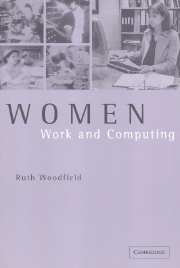Book contents
- Frontmatter
- Contents
- Preface
- List of abbreviations
- 1 The myth of the neutral computer
- 2 Computers, communication and change
- 3 Softech: a ‘twenty-first-century organisation’
- 4 Male and female pathways through the unit
- 5 Hybrids and hierarchies
- 6 Understanding the relationship between gender and skill
- 7 The female future and new subjectivities
- Conclusion: is the future female?
- List of references
- Index
2 - Computers, communication and change
Published online by Cambridge University Press: 22 September 2009
- Frontmatter
- Contents
- Preface
- List of abbreviations
- 1 The myth of the neutral computer
- 2 Computers, communication and change
- 3 Softech: a ‘twenty-first-century organisation’
- 4 Male and female pathways through the unit
- 5 Hybrids and hierarchies
- 6 Understanding the relationship between gender and skill
- 7 The female future and new subjectivities
- Conclusion: is the future female?
- List of references
- Index
Summary
Computers and communication
The evidence reviewed in this chapter seeks to provide support for the suggestion that despite the existing quantitative and qualitative domination of computing cultures and skills by men, there are good grounds for predicting that this will cease in the future. The rationale which underpins the first of the two remaining optimistic perspectives on the unfolding women–computer relationship centres upon the core belief that since the mid-1980s, and originating within the commercial arena, the culture and practices of computing have experienced dramatic changes that should, in time, make the field far more amenable to female entrants. Furthermore, these changes should mean that female computer professionals will be deemed by themselves and others to be more suited to occupational computing than their male counterparts.
Creating the interface: the commercialisation of the computer industry
As follows from the previous chapter, the strong cultural identity which has surrounded the field of computing has often led to the development of practices by the designers, developers and vendors that were almost exclusively focused upon the technology itself, and in many cases purely upon what has been called ‘the thrill of inventiveness’ (Glastonbury 1992: 112), rather than on the requirements of users or the commercial viability of the technical product.
- Type
- Chapter
- Information
- Women, Work and Computing , pp. 30 - 49Publisher: Cambridge University PressPrint publication year: 2000



